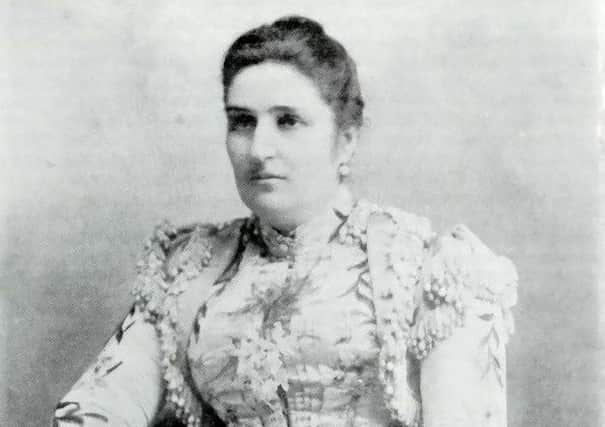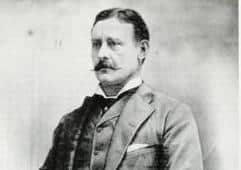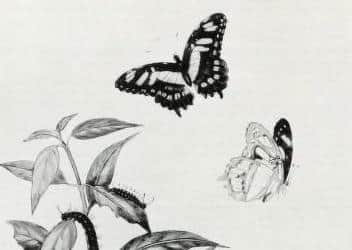Multilingual writer, traveller and artist eloped with policeman


Tipperary-born Edith Osborne (later Lady Edith Blake) also penned three plays and multiple newspaper features, painted widely-exhibited watercolours, studied architecture, botany and Lepidoptera, wrote histories of Africa, China and Ireland and protected her Colonial Diplomat husband Henry - with an always-loaded pistol!
Born on February 7, 1846 in Newtown Anner House, near Clonmel, County Tipperary, Edith Osborne had a privileged but troubled upbringing.
Advertisement
Hide AdAdvertisement
Hide AdHer MP father Ralph Bernal Osborne’s marriage to her wealthy mother, Catherine Osborne (whose surname he added to his own) was a marriage of convenience in which both seemed to actively hate each other.


While her father lived mostly in London, embarking on frequent extramarital affairs, her mother lived with Edith and her sister Grace on their Tipperary estate, introducing them to art and nature.
Edith disliked her philandering dad, revering her mother as a ‘suffering angel.’
When Edith was in her late teens, her mother wrote a novel called False Positions, an anonymous and thinly disguised attack on her husband.
Advertisement
Hide AdAdvertisement
Hide AdMrs Osbourne was a talented artist and encouraged both her daughters to take up artistic pursuits. Famous painters often stayed at Newtown Anner, sometimes tutoring the sisters in art.


But Edith’s parents constantly defended their two daughters from an imaginary barrage of ‘fortune hunters’. Her mother in particular insisted on verifying that her daughters’ boyfriends weren’t merely wooing bounty.
So 28-year-old Edith eloped with widower Henry Blake, then the County Inspector for the Royal Irish Constabulary. She was promptly disinherited and the newlyweds moved to Belfast where Olive, their first child, was born.
Keen to progress, Henry became Resident Magistrate in Tuam where he oversaw mass evictions, arrests and trials during the height of the Land War.
Advertisement
Hide AdAdvertisement
Hide AdWith her husband so greatly disliked, and amidst such widespread animosity, Edith carried a pistol with her at all times in case an attempt was made on his life.
Yet while Henry was an inveterate ‘servant of Empire’ Edith was a close friend and supporter of Anna Parnell, founder of the Ladies’ Land League, and roundly condemned Charles Stewart Parnell when he suppressed it in 1882.
With Henry’s life regularly under threat, and after a number of assassination attempts, the British administration felt it would be better to post him overseas.
They wanted to make him Governor of Queensland but the resident Irish community there obstructed the appointment.
Advertisement
Hide AdAdvertisement
Hide AdHe was instead installed as Governor of the Bahamas in 1884, the first of five governorships he held over 27 years - the others being Jamaica, Hong Kong, Newfoundland and Ceylon (Sri Lanka).
Henry was knighted and his wife became Lady Edith Blake.
She absolutely loved life overseas and despite her official duties as Governor’s wife, she refused to spend too much time entertaining the wives and partners of the great and the good. Rather, she painted absolutely wonderful watercolour paintings, specialising in botanical scenes, particularly butterflies, plants and landscapes.
She was a very gifted artist with the ability to capture minute detail, doubtlessly picked up from her mother and the artists who stayed on their Tipperary estate.
Edith’s paintings were shown in 1894 in a special exhibition at Dublin’s Museum of Science and Art, which became the National Museum of Ireland.
Advertisement
Hide AdAdvertisement
Hide AdLater she bequeathed her collection of nearly 200 watercolours to the British Museum, now held by the Natural History Museum in London.
She was also a gifted linguist and could speak nine languages - English, Irish, Spanish, French, German, Portuguese, Italian, Russian and Mandarin.
A clear and concise writer, she published two books and three plays, and was also a frequent contributor to many leading journals including The Nineteenth Century magazine, the Illustrated London News and The North American Review.
She was also a fine horsewoman, known as “a daring rider in the hunting field.”
Advertisement
Hide AdAdvertisement
Hide AdOne of her books published in 1876 - Twelve Months in Southern Europe - was the illustrated diary of her travels in 1872 to nine European countries, and during her life as a diplomat’s wife she wrote a history of the Maroons (escaped African slaves) of Jamaica, the restoration of the Ming Dynasty, the position of women in China and life and death in Ireland.
After Henry’s retirement they returned to Ireland in 1907, settling in Youghal in a Tudor manor house, once home to Sir Walter Raleigh.
Henry accepted a seat as a Southern Unionist in the Irish Convention which was established in 1917 in response to the demands of Home Rule.
He died on February 23, 1918, described in an obituary as “a man of a broad and well-cultured mind and an interesting and delightful lecturer.”
Advertisement
Hide AdAdvertisement
Hide AdAfter his death the grieving Edith would rarely leave the house except to sit alone in the garden.
She had rheumatism and only wore black clothes in mourning. She sought the services of a psychic medium (one of her very few visitors) to try to make contact with her beloved husband in death.
Lady Edith Blake died on April 18, 1926.